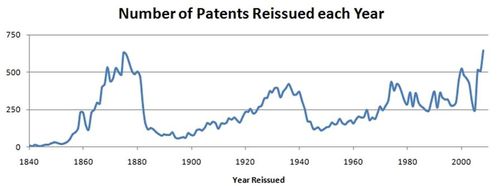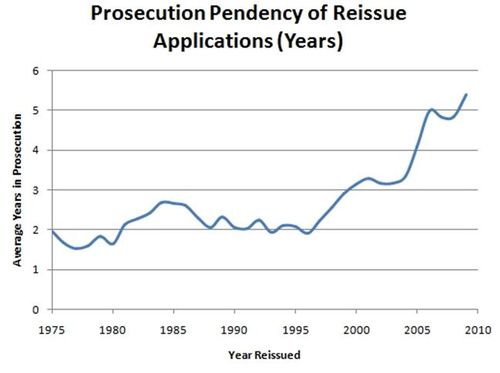In 2008, the patent office reissued over 640 patents – breaking the prior record of 630 set in 1875. The historic numbers of reissued patents are shown in the first chart below grouped according to year of reissuance.

Although today's absolute numbers rival historic highs of the 19th century, today's relative number of reissued patents is close to the all-time low. The next chart shows the relative percentage of reissues as compared to utility patents granted (denominator based on a moving average of patents issued over of the prior ten years).

The final chart shows a time series of the average reissue pendency as measured from the reissue application filing date to the reissuance date. As is apparent, the pendency has been growing dramatically since 1997. 2009 looks to mark a second record – the first time that average prosecution pendency of reissues applications will be greater than five years.

Background: The reissue process is designed to allow a patent holder to correct a defective patent and is nestled between certificates of correction (minor errors) and reexamination. 35 U.S.C. §251 spells out particular defects that may be corrected in the process: Defect in the specification; Defect in the drawing; Error in claiming too much; or Error in claiming too little. In Medrad, the Federal Circuit broadly read these final two defects to "encompass any error that causes a patentee to claim more or less than he had a right to claim." Medrad, Inc. v. Tyco Healthcare Group LP, 466 F.3d 1047 (Fed. Cir. 2006). A major limit on the reissue process is that "[n]o reissued patent shall be granted enlarging the scope of the claims of the original patent unless applied for within two years from the grant of the original patent." Section 251, final paragraph. The limit on improper broadening of reissues is strict and applies when claims are "broader in any respect." Predicate Logic, Inc. v. Distributive Software, Inc., 544 F.3d 1298 (Fed. Cir. 2008).
Dennis,
Please delete comments when they include racially inappropriate remarks. I know you are the most popular blog, but I think you may lose a lot of us if you don’t keep it clean. I do not wish to be in silent consent to racially inappropriate remarks going unchallenged on a blog that is moderated.
Thank you Mr. Pirelli. I thought I was the only one interested in what happened then. New patent law? Threatening to shut the patent office down because nothing left to patent? The Civil War and actions against patents held by CSA citizens? Greenwood and the concept of obviousness? The sewing machine wars
(link to papers.ssrn.com)?
Interesting. It would be interesting to know the number of reissue patents relative to the number of patents issued and unexpired at the relevant time. I suspect the 1875 number still represents a much greater percentage than the 2009 number.
There was a rise in reissue during the 1998-2000 internet boom and a fall in reissue during the internet bust of 2000-2005.
KSR came out in the Fed. Cir. in 2005 and in the US Supremen court in 2007. Note how reissues rapidly increased in both years.
For you history buffs, why the rise from 1850 to 1875? Railroad boom? and why the fall after 1875?
Another reason for decreased reissues is the common practice of keeping a continuation or divisional alive on an important patent. This allows dealing with design arounds and new prior art, without going through the reissue process and without dealing with the recapture doctrine.
Yes, good point, the “recapture doctrine” can prevent broadening (without also narrowing) claims in a broadening reissue as to claim scope surrendered in the original prosecution by claim amendments or attorney arguments or failure to ever file a divisional on restricted-out claims. But the recapture doctrine does not affect claims that do not get broadened in a reissue application. Also, trying to rely on the DOE to broaden original claim scope in litigation these days, instead of doing it by reissue, is normally hopeless.
Some of the CAFC inter-panel inconsistency, in applying the recapture doctine instead of the broadening reissue statutory intent, seemed to me to be due to early CAFC decisions citing very old reissue case law based on the OLD reissue statute, which had different language.
The real danger in reissues is rather the illegal broadening of any claim in any respect in a reissue filed more than two years after the patent issues (even if also narrowing the claim). That has been held fatal to enforcement of the entire patent by the CAFC. It could also get someone charged with inequitable conduct and an ethics violation, since ignorance of the law by a registered practitioner is an unlikely excuse.
>Because most people keep a >continuation pending ….
Ridiculous unsupportable non-statistic.
“dreaded “recapture” taffy pit”
Yes, recapture is a mess.
“what happened around 2004 which caused the prosecution pendency to shoot up?”
The PTO started examining the applications instead of rubber stamping them as it had been doing for the previous ten years.
“I would be interested in comments of others as to why so very few reissues are filed?”
Because most people keep a continuation pending and would rather pursue claims with a continuation than risk having their granted claims taken from them.
In some cases, however, for whatever reason (lack of funds) a continuation is not filed. A licensee may be interested, however, in pursuing matter that was not claimed. If a credible argument for an “error” in the existing application can be made, voila! you can prosecute away. If you present your “error” before the two year deadline, you can pretty much go after any claims you want provided you avoid the dreaded “recapture” taffy pit.
Paul, I think that the increase in the pendency is also a factor. I think patents are more thoroughly prosecuted nowadays and the chance of catching an error, either by the office or by the applicant, has increased as a result.
what happened around 2004 which caused the prosecution pendency to shoot up?
I would be interested in comments of others as to why so very few reissues are filed?
Here are a few thoughts:
1. Few patents are thoughly reviewed for unnecessary claim limitations or other correctable errors within two years of their issue, because only approximately 1% or less of all patents are ever asserted, and those asserted are primarily older patents.
2. The strong human tendency of anyone involved in the original preparation or prosecution of the patent to want to avoid the required reissue oath admission of making a mistake.
3. Those anxious to sue on a patent may not want to wait the years of PTO delays of a reissue, and/or
4. risk the additional prosecution history, and possible creation of the statutory “intervening rights” defenses by amending or cancelling claims.
Other reasons? Or disagreements?
Re: “the pendency has been growing dramatically since 1997. 2009 looks to mark a second record – the first time that average prosecution pendency of reissues applications will be greater than five years.”
Thank you for confirming my previously published impressions that the PTO has been disgracefully delaying reissue applications as well as reexaminations. Reissues are supposed to be promptly handled because most of them are important patents being reissued to better protect products or for possible assertions. This demonstrates another serious docket control failure of the recent PTO management as to what is really important. The small number of reissues, less than 700 a year, makes these PTO delays of important cases particulary inexcusable, because it could be so easily addressed at no increased cost.
Comments are closed.